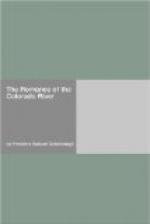* The introduction of this subject may seem unnecessary to the general reader, but no just comprehension of this river can be reached without some knowledge of the forces creating its chasms.
To produce canyons like those of the Colorado, peculiar and unusual conditions are necessary. There must exist a vast region lying high above sea-level. This region must be arid. Out of it must rise separated mountain masses to such heights that they shall be well watered. These most elevated regions alone having abundant rain- and snowfall, torrential streams are generated and poured down upon the arid wastes, where they persistently scour their beds, ploughing deep channels below the level of their surroundings. The perpendicularity of the walls of these channels, or canyons as they are called, depends on the volume and continuity of the flowing stream, on the aridity of the country through which they are cut, and on the rock-formation. A fierce and continuous torrent, where the rainfall is at the minimum, will so speedily outrival the forces of erosion that the canyon will have vertical walls. An example is seen in those frequent “mud” canyons found in arid regions, where some brook, having its source in highlands, cuts a channel through clay or dry earth with vertical sides, that stand for years. As long as the surface of the adjacent lands is undisturbed, it acts like a roof, throwing off the water that falls upon it into the main stream.* Thus the foundations of these walls are not assailed from behind, which is their weakest point. If the land surface is broken up, permitting the rains to soak in and saturate the clay or earth, the whole mass becomes softened and will speedily fall and slide out into the canyon.**




